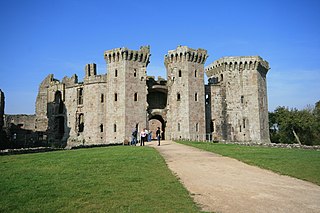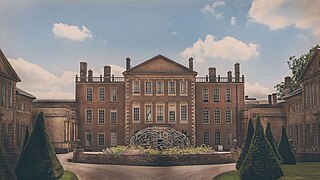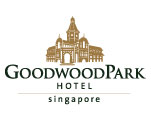
Swansea is a coastal city and the second-largest city of Wales. It forms a principal area, officially known as the City and County of Swansea.

Shugborough Hall is a stately home near Great Haywood, Staffordshire, England.

Raglan Castle is a late medieval castle located just north of the village of Raglan in the county of Monmouthshire in south east Wales. The modern castle dates from between the 15th and early 17th centuries, when the successive ruling families of the Herberts and the Somersets created a luxurious, fortified castle, complete with a large hexagonal keep, known as the Great Tower or the Yellow Tower of Gwent. Surrounded by parkland, water gardens and terraces, the castle was considered by contemporaries to be the equal of any other in England or Wales.

Skibo Castle is located to the west of Dornoch in the Highland county of Sutherland, Scotland overlooking the Dornoch Firth. Although largely of the 19th century and early 20th century, when it was the home of industrialist Andrew Carnegie, its origins go back much earlier. Andrew Chirnside was a previous owner.

Aynhoe Park, is a 17th-century country estate consisting of land and buildings that were rebuilt after the English Civil War on the southern edge of the stone-built village of Aynho, Northamptonshire, England. It overlooks the Cherwell valley that divides Northamptonshire from Oxfordshire. The core buildings represent four architectural periods: Jacobean, Carolean and both the early 18th and 19th centuries. The estate has been owned by Restoration Hardware since 2020.
Blackpill is a suburban area of Swansea, Wales, beside Swansea Bay, about 3 miles (4.8 km) southwest of the city centre.

Singleton Park is the largest urban park in the city of Swansea. It is located in Sketty.

The Goodwood Park Hotel is a heritage hotel in Singapore, situated in a 6-hectare landscaped garden on Scotts Road. It was first built as the club house for the Teutonic Club serving the expatriate German community in Singapore, and later converted into a hotel.

Laugharne Castle is in Laugharne, Carmarthenshire, Wales. The castle, located on the estuary of the River Tâf, was originally established in 1116. It was rebuilt as a Norman stronghold. There have been many alterations since then, including becoming a Tudor fortified manor house in the sixteenth century. It changed hands twice during the English Civil War, being eventually captured by Parliamentary forces in 1644.

Sketty Hall is a venue used for hosting social functions, business functions and conferences in Singleton Park, Swansea, south Wales. The original building was built in the early 18th century as a private house. Over the years it has seen a number of extensions, modifications and changes of use to its present-day role.
The suburban district of Sketty is about 2 miles (3.2 km) west of the Swansea city centre on Gower Road. It falls within the Sketty council ward of Swansea. It is also a community.

Clyne Gardens is a botanical garden located in Swansea, Wales, UK. The current park was formed from the landscaped gardens created by Glynn Vivian of the Vivian family who purchased Clyne Castle in 1860. The estate passed to his nephew Algernon, 'The Admiral' in 1921 who owned it until his death in 1952. Clyne Gardens is bordered by Mumbles road and Mayals road in Blackpill and Mayals areas of Swansea with entrances off both these roads. The gardens are listed on the Cadw/ICOMOS Register of Parks and Gardens of Special Historic Interest in Wales.
The Clyne Valley Country Park is an area of parkland in Britain, at Swansea in south Wales. It lies on either side of the valley of the Clyne River and comprises an area of over 700 acres (280 ha) of land running from the sea at Blackpill, Swansea, inland to Gowerton. It is an area of once splendid woodland with enormous beech, ash and oak trees mainly on the Mumbles side of the Clyne River, and, on the Swansea side, woods and mainly scrub land that has naturally regenerated a reclaimed refuse tip. The valley forms an important link in the ecological corridor that runs from the Brecon Beacons and the Black Mountain across commons and on into the Gower AONB. The Area of Outstanding Natural Beauty forms part of the valley's boundary along Clyne Common. Now dormant – apart from the rich habitat that has formed from neglect – the valley at one time was part of the Vivian estate. During the eighteenth and nineteenth centuries it was a highly active industrial area with a long history of coal mining, mineral workings, brick making, charcoal burning, railways and canals.

Ramsay Garden is a block of sixteen private apartment buildings in the Castlehill area of Edinburgh, Scotland. They stand out for their red ashlar and white harled exteriors, and for their prominent position, most visible from Princes Street.

Willersley Castle is a late 18th-century country mansion above the River Derwent at Cromford, Derbyshire, outside Peak District National Park. The castle has been a Grade II* listed building since April 2000.

Pitfour Castle is an 18th-century country house situated on the southeast edge of the village of St Madoes in the Carse of Gowrie, Perthshire, Scotland. It is a Category A listed building.

In the United Kingdom, the term listed building refers to a building or other structure officially designated as being of special architectural, historical, or cultural significance; Grade II* structures are those considered to be "particularly important buildings of more than special interest". Listing was begun by a provision in the Town and Country Planning Act 1947. Once listed, strict limitations are imposed on the modifications allowed to a building's structure or fittings. In Wales, the authority for listing under the Planning Act 1990 rests with Cadw.
Glamorgan County Council was established in 1889 together with the administrative county of Glamorganshire under the Local Government Act 1888. The first elections to the council were held in January 1889. The council was abolished under the Local Government Act 1972 on 1 April 1974. It was replaced by Mid Glamorgan County Council, South Glamorgan County Council and West Glamorgan County Council.
Vivian is the name of a British noble family of Cornish extraction that rose to wealth in various regions of the British Isles. Over time, several members of the Vivian family were made knights, baronets and peers. Hereditary titles held by the family include the Vivian barony as well as the Swansea barony. Several other members of the family have also risen to prominence.















